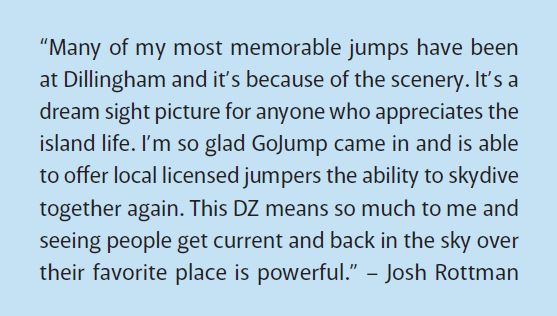For decades, skydivers have enjoyed tranquil, seaside skydiving at the Kawaihaipai (aka Dillingham) Airfield, near the town of Mokuleia on the northside of the Island of Oahu. Unlike any other drop zone in the U.S., the location is truly magical with the runway tucked away on the North Shore, surrounded by quintessential Hawaiian gardens. Dillingham is adjacent to the famous surf spot known as “Pipeline,” and above the runway towers the perfect topography for constant ridge lift that benefits all types of flyers, from aircraft and skydivers to gliders and powered hang-gliders.
If you’ve been to the airport, you may have noticed a military ambiance coupled with the laid-back, tin-roof building style of 1960s Hawaii. The two-mile long runway was constructed in 1942, at the start of World War II, and is still owned and used by the U.S. Army. Twenty years later, the Army started leasing the airport to the Hawaii Department of Transportation, which in turn leased parcels to various aviation entities, including drop zones. There has been skydiving there since at least the 1960s; at times there have been up to four DZs operating simultaneously at the airport.
In June of 2019, tragedy struck paradise, and the skydiving community lost 11 lives when a King Air operated by Oahu Parachute Center crashed shortly after takeoff. (The National Transportation Safety Board eventually concluded that the probable cause was the pilot’s aggressive takeoff maneuver.) By February 2020, the healing had only just begun, and Dillingham was back to two DZs. Still, business was booming when all of the airport tenants received an abrupt notice from the Hawaii Department of Transportation that they were not renewing the lease with th e Army and to cease operations and vacate their hangars within six months! This was devastating, as there was no other airport on Oahu that could accommodate skydiving.
e Army and to cease operations and vacate their hangars within six months! This was devastating, as there was no other airport on Oahu that could accommodate skydiving.
Airport Access in Action
USPA sprang to action and soon discovered it had a unique asset at the airport: member and senior rigger Ben Devine, who has a mind for organization and political activism. Ed Scott and Randy Ottinger, who were then USPA Executive Director and Director of Government Relations, respectively, worked closely with Devine, and the trio swiftly ensured that the area’s state legislators and a coalition of aviation groups rallied to the cause.
USPA also sent a letter to the FAA’s Western-Pacific Region Airports Division, which oversees federal grants for Hawaii airports. The FAA quickly inserted itself into the issue, advising the state of its continuing obligations and requesting a plan “that would accommodate all civil aviation tenants.” Within eight days of the FAA letter, the DOT postponed by a year—to June 2021—the date by which tenants would have to vacate. Now there was breathing room.
Meanwhile, USPA came up with a novel plan to ensure that Hawaii’s legislators were fully aware of the human toll of closing the airport to civil aircraft. A USPA audiovisual team was quickly dispatched to Oahu to interview those at the DZs who would lose their jobs, their livelihoods and their homes should the airport close. Directed by USPA Director of Sport Promotion Shanon Searls and filmed and edited by USPA member Mike Naddorious, the resulting Save Our Sky video (available on the SkydiveUSPA YouTube channel) successfully brought a human element to a political issue. Widely shared with an action call to contact the governor and state legislators, the effort generated nearly 3,000 emails and letters in support of the airport.
The groundswell of public opinion had its effect. In September 2021, Hawaii DOT announced it was withdrawing the termination notice and would continue operating the Dillingham Airport for the public. Meanwhile, state legislators are working to solidify language that will keep the airport open for decades to come.
USPA is Committed to Every Group Member
USPA received some skydiver criticism throughout the effort. Why was the association using resources to save an airport that hosted two DZs, one of which was tandem-only, where fun-jumpers, including visitors and locals alike, were not very welcome? USPA had two answers.
First, USPA had a duty to protect the livelihoods of the many individuals who worked at the two DZs. Together, they employed more than 100 staff—tandem instructors, packers, riggers, manifest and ground personnel, and others—whose livelihoods and very lives would have been disrupted. Most would have had to give up their skydiving jobs; many would have had to leave Hawaii. It would also have affected employees of the various other businesses at Dillingham, and it would have been a devastating blow to the North Shore community of Oahu.
Second, preserving the airport also preserved the possibility that a full-service DZ could one day serve the airport. Losing the airport guaranteed that skydivers would never have the opportunity to jump there again.

In July at GoJump Hawaii, jumpers fly a 10-way head-down formation (opposite page) and an 8-way head-up formation, which they are planning to submit to USPA as state records.
And, as if on cue, earlier this year a new drop zone announced its intent to open at the Dillingham Airport after purchasing Pacific Skydiving Center. GoJump Hawaii flew its first loads on May 11. And yes, fun jumpers are welcome. According to information provided by the drop zone, fun jumpers must have a USPA C license or foreign equivalent, show proof of having made at least 10 jumps in the previous 12 months, have an airworthy rig equipped with an automatic activation device, have a positive and safety-focused attitude and get cleared by the GoJump Hawaii Safety and Training Advisor. The DZ is making a special effort to help local jumpers, who have been without a regular DZ for so long, by offering Hawaii residents assistance and training to meet the licensing and currency requirements.
 The new Hawaii DZ is one of three GoJump America DZs across the U.S., all owned by Mike Vetter, a champion skydiver and passionate drop zone operator and businessman. He believes that the success of his drop zones can be attributed to GoJump’s dedication to the tandem-customer experience, but also understands that licensed jumpers are the lifeblood of the skydiving community. Without them, instructors would cease to exist, and the industry would die out.
The new Hawaii DZ is one of three GoJump America DZs across the U.S., all owned by Mike Vetter, a champion skydiver and passionate drop zone operator and businessman. He believes that the success of his drop zones can be attributed to GoJump’s dedication to the tandem-customer experience, but also understands that licensed jumpers are the lifeblood of the skydiving community. Without them, instructors would cease to exist, and the industry would die out.
Currently, GoJump Hawaii is offering a ticket to 14,000 feet for $35, which most business-minded skydivers can calculate is cost-covering at best. This is why Vetter promotes the importance of the tandem customer and asks our licensed-skydiver community to play a part in the tandem experience by showing patience instead of frustration while waiting for the occasional tandem load to send.
USPA Will Continue to Fight
Each year, USPA handles a number of cases where the continuation of a drop zone faces threats. More rarely is the association involved in an issue that threatens both the airport and a DZ. With so much at stake at Dillingham, preserving that special piece of sky is gratifying. And it proves that when skydivers join together, the sky is truly limitless.
In-depth information about USPA’s fight to save skydiving in Hawaii can be found in “Saving Dillingham” by Luke Jones in the February 2021 issue of Parachutist, available under the Back Issues tab.